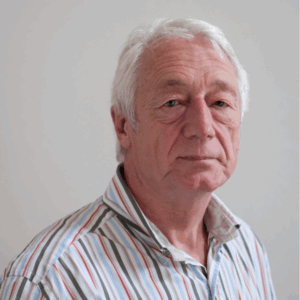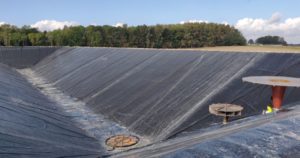Denmark: Dronninglund Inaugurates 26 MWth Solar District Heating Plant
June 1, 2014
 The world’s currently largest solar district heating plant was inaugurated in Dronninglund, Denmark, on 2 May this year. The photo shows Carsten Møller Nielsen, Board Chairman at Dronninglund Fjernvarme, welcoming Rasmus Helveg Petersen, Danish Minister for Climate, Energy and Building (to the left of the speaker). The system consists of 2,982 collectors with a total solar thermal capacity of 26 MWth (37,573 m²) and a 61,700 m³ seasonal pit heat storage and is planned to provide about 15,000 MWh per year. Its output will meet half of the annual heat demand of the plant’s 1,350 customers. According to the local district heating supplier Dronninglund Fjernvarme, the total investment costs for the plant amounted to DKK 106 million (EUR 14.6 million), of which EUR 6.1 million were invested in the solar installation (see the chart below). The plant was subsidised by the Danish Energy Technology Development and Demonstration Program, EUDP, which supported the project with Danish Krone (DKK) 21 million (EUR 2.953 Mio). The payback period is said to be 25 years. Solarthermalworld.org spoke with Søren Elisiussen, CEO at Arcon Solar, which delivered the collectors and the support structure for the solar field, about the plant’s technical specifications.
The world’s currently largest solar district heating plant was inaugurated in Dronninglund, Denmark, on 2 May this year. The photo shows Carsten Møller Nielsen, Board Chairman at Dronninglund Fjernvarme, welcoming Rasmus Helveg Petersen, Danish Minister for Climate, Energy and Building (to the left of the speaker). The system consists of 2,982 collectors with a total solar thermal capacity of 26 MWth (37,573 m²) and a 61,700 m³ seasonal pit heat storage and is planned to provide about 15,000 MWh per year. Its output will meet half of the annual heat demand of the plant’s 1,350 customers. According to the local district heating supplier Dronninglund Fjernvarme, the total investment costs for the plant amounted to DKK 106 million (EUR 14.6 million), of which EUR 6.1 million were invested in the solar installation (see the chart below). The plant was subsidised by the Danish Energy Technology Development and Demonstration Program, EUDP, which supported the project with Danish Krone (DKK) 21 million (EUR 2.953 Mio). The payback period is said to be 25 years. Solarthermalworld.org spoke with Søren Elisiussen, CEO at Arcon Solar, which delivered the collectors and the support structure for the solar field, about the plant’s technical specifications.Photo: Arcon Solar
Solarthermalworld.org: Danish project planner PlanEnergi calculated very low specific investment costs of 155 EUR/m² for the solar installation in Dronninglund. Did you meet this goal?
Elisiussen: To the best of my knowledge, Dronninglund completed the project on budget. The total project sum of DKK 106 million seems correct to me. We delivered the collector field, the support structure and the piping between collectors in the field.
Solarthermalworld.org: At the SMEThermal conference in Berlin, Germany, in February this year, you mentioned that the typical investment costs of a ground-mounted 10,000 m² collector field were 200 EUR/m². Compared to a 10,000 m² field, the 36,000 m² has been 30 % cheaper. How did you achieve the cost savings?
Elisiussen: During the last years, Arcon has managed to optimise both the product and the production. This has resulted in significant improvements in both performance and costs. Add to this the size of the Dronninglund field, which provided additional synergies. One of the more important improvements was the new and innovative steel profile foundation. The Dronninglund project was originally intended to be installed on concrete pillars, moulded onsite, but Arcon developed the steel foundations and offered those on the Dronninglund project as a cost-saving initiative to the customer. Today, Arcon primarily installs collectors on steel profiles and we have acquired the necessary machinery and hired the right specialists to install them.
Solarthermalworld.org: Please explain the hydraulic design of the collector arrays at 36,000 m².
Elisiussen: It’s two collector fields with rows of 20 collectors in series. All collectors are Arcon 35/10 HEATstore collectors with insulating foil, 35 mm riser tubes and 10 mm strips.
Solarthermalworld.org: What opportunities for optimisation do you see in this area?
Elisiussen: We at Arcon are continuously working on further improving the cost-performance ratio of the collectors and the installation process. We are currently implementing changes to our production lines to optimise material use and production efficiency and to improve the collector’s physical properties. Regarding the complete solution, it has been my impression that the combination of high-performance flat plate collectors and seasonal storage is maturing now, based on past experiences. Arcon has just signed a contract last week to deliver a 52,491 m² collector field for an installation in Vojens, Denmark, with 180,000 m³ of seasonal storage. So, the solution, a large solar field with storage, is maturing and turning into a proven technology with minimal risk, which can be used all over Europe to reduce the dependency on fossil fuels and reduce long-term heat costs.
Solarthermalworld.org: At SMEThermal, you mentioned that you use eight different collector types in larger fields to optimise hydraulics. Was this special design also used in Dronninglund?
Elisiussen: Dronninglund has only one type of collector, the above-mentioned 35/10 HEATstore with foil, because of the rectangular field connected to seasonal storage. The other types are commonly used to optimise non-rectangular fields with rows of different lengths. We have already had several plants with this field combination. When designing a field layout, Arcon uses its years of experience with the different collector models to achieve an optimal cost-performance ratio.
Solarthermalworld.org: What is your aim with the special design?
Elisiussen: We aim at optimising flow and making sure we have turbulent flow all over the field at all times, as it improves overall performance.
Solarthermalworld.org: What are the different technical features of the collector types?
Elisiussen: There is a version with 10 mm strip dimensions and a version with 8 mm strip dimensions. Both versions come with and without foil. We have discontinued the 28 mm riser tube versions due to production optimisations, so all collectors now have 35 mm riser tubes. This enables us to design collector fields with long rows of collectors (up to 22 in a row) to best accommodate the requirements of the district heating station.
Solarthermalworld.org: With regard to future projects, can you estimate how much the optimised hydraulics have improved efficiency?
Elisiussen: We need more detailed calculations and measurements before we can precisely quantify the improvement. We are currently involved in a PhD project that aims at modelling the increase.


